Menu

Did you know the livestock market in the United States is worth more than $30 billion each year? With nine million dairy cows needing care, it’s no surprise. Farmers use livestock productivity tools to work more efficiently. This helps meet the rising needs for milk, meat, and other items.
Animal health monitoring and new breeding technologies are changing the game for farmers. These tools mix old farming knowledge with new tech. This helps farms run better and more sustainably. By improving how animals are bred, fed, checked for diseases, and managed, farm animals are more productive.
Adding livestock productivity tools to farming is crucial. It helps make farms more efficient and profitable. These tools include the latest tech and methods. They focus on improving breeding, nutrition, and health of animals. This makes farming more effective and boosts animal production.
Using livestock management apps is key in this change. These apps help track animals’ health, food, and where they go. They give real-time data that helps with decisions and managing resources. With these apps, farmers can up their game in production and resource management.
Also, improved handling and moving equipment have changed how we deal with livestock. Things like chutes, alleys, and robots make tasks easier. They also keep animals and workers safer.
Tools for checking the health of animals are important too. Items like thermometers and ultrasounds help keep animals healthy. They catch health problems early, allowing for quick fixes. Special tools for vets are vital for caring for wounds and giving medicine.
Good farm buildings, like barns, are part of a successful farm. So are modern ventilation and waste disposal systems. These things create a healthy, productive space for animals. This leads to better efficiency on the farm.
Improving livestock tools is part of modernising farming. It connects farmers with global goals. It strengthens food safety and helps farmers tackle the effects of climate change.
Improving breeding programs boosts the output of livestock by focusing on the best traits. These include quick growth, high milk yield, and fighting off diseases. A strong breeding plan ups the farm’s productivity. It also supports good farming for the long term. With genomic selection, genetic testing, and crossbreeding, farmers choose the best breeding stock. This leads to animals with top-notch traits.
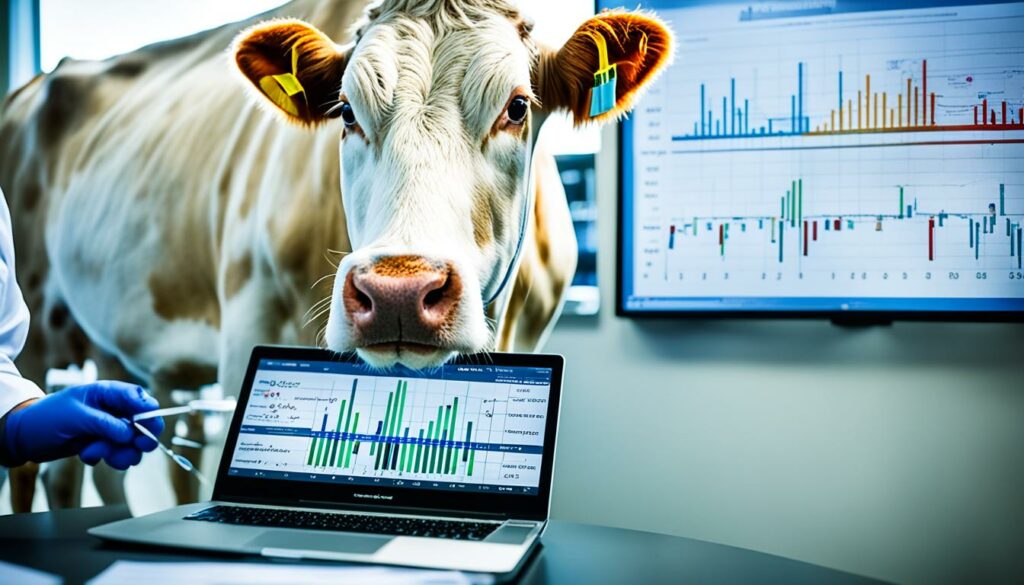
Keeping detailed records is critical for successful breeding. It tracks results, family lines, and guides future breeding choices. Apps like Cattlytics make it easier to keep track. They help make smart breeding decisions based on data.
Genomic selection and genetic testing are modern tools to pick the best animals for breeding. They find important genes that lead to desired traits. Genetic tests make sure the animals are healthy and don’t have genetic problems. This raises the quality of the whole herd.
By using crossbreeding, farmers can get animals with better traits than purebreds. It mixes different genetic lines to avoid issues like inbreeding. The result is livestock that’s stronger and more efficient. Advanced techniques like artificial insemination improve these results further.
| Breeding Strategy | Benefits |
|---|---|
| Genomic Selection | Identifies superior genes for specific traits, enhancing breeding decisions |
| Genetic Testing | Ensures selection of healthy breeding stock, free from genetic defects |
| Crossbreeding | Combines desirable traits, leveraging hybrid vigour for superior offspring |
| Detailed Record Keeping | Informs future breeding decisions and maintains genetic lineage |
To make livestock more productive, it’s key to use the right nutrition. Animals must have a balanced diet. This ensures they grow well, stay healthy, and work at their best.
Creating a balanced diet for animals takes a lot of thought. We need to look at their age, sex, size, and what state they’re in. Energy is a big deal. It makes up most of what animals need to eat to function well. A good diet stops them from getting sick and keeps their productivity up.
Some places have bad forage. But, we can make it better by adding certain supplements. For example, urea molasses blocks can boost the value of feed. This makes animals digest better and use more energy from their meals. Also, by improving feed, we may reduce the greenhouse gases they produce.
Livestock farming uses a lot of land and is worth a huge amount. The right nutrition can help farms be more successful and better for the planet. This way, everyone wins.
Keeping an eye on the health of livestock is key. With high-tech solutions, we watch over their well-being closely. This proactive approach lets us spot and solve health issues early, preventing bigger problems.
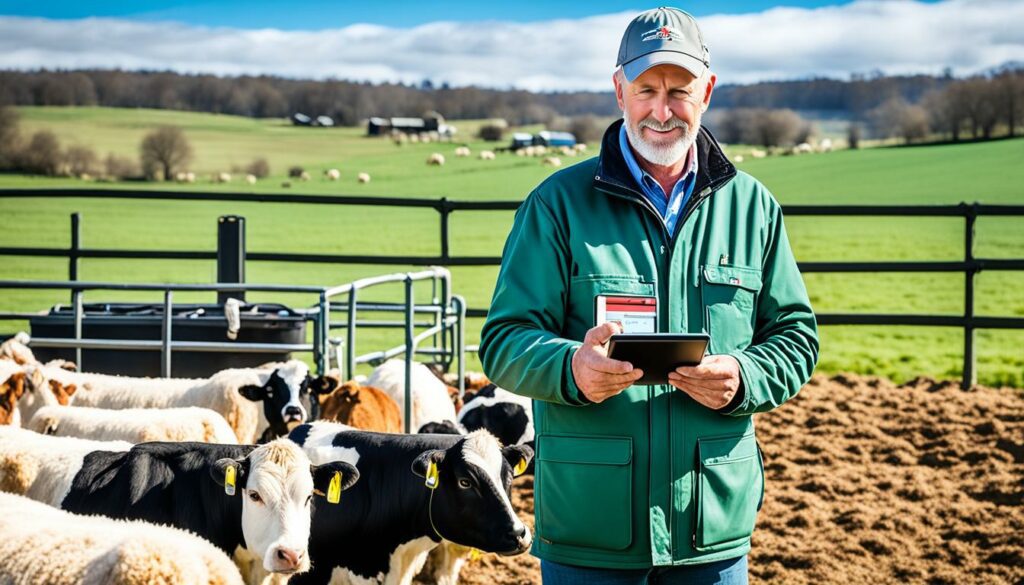
Regular health checks are vital for keeping diseases at bay in livestock. By monitoring them often, farmers can notice if something’s off in how the animals eat or act. A healthy cow chews its cud for about 500 (+100) minutes every day. Any big changes could mean they have a health problem. Using tools like Allflex’s cattle health monitoring helps catch these signs fast.
Keeping an eye on when cows are in heat is also crucial. Cows that are in heat show it by being more active or letting others mount them. Timing is key, with the best chance to get pregnant lasting around 12 hours. By watching these signs, farmers can improve how many calves they get each year. This boosts the farm’s output. Watching how much cows chew after giving birth helps too. It can reveal if they’re sick, making sure they keep producing milk well.
Being ahead in taking care of livestock health is crucial. It involves having detailed health plans made with vets. These plans stress on the regular checks and early care.
Cattle Scan tech is a big help here. It keeps an eye on the animals’ vital signs all the time. When something seems wrong, it sends an alert. This lets farmers step in quickly, avoiding bigger problems and costs.
There’s more to keeping animals healthy than just health checks. It’s also about their water, food, and the weather. Monitoring these keeps animals from getting too hot or sick. It makes sure they’re doing well. Managing these details makes fighting diseases in animals easier. This ensures your farm stays healthy and productive.
By combining standard health checks with active health plans, livestock management becomes strong. This serves both the animals and the farm well. It creates a balance between good care and high production.
Precision livestock farming (PLF) is changing how we run farms for the better. With more people wanting meat, eggs, and dairy, and fewer spaces for farms, PLF is tackling today’s farming issues head-on. It uses new tech to make sure our farms work as well as they can.
In the heart of PLF is managing with data. Thanks to cool new tech, farmers can now collect loads of data about their animals. They use things like automatic weighers and GPS trackers. This tech helps monitor how healthy and productive the animals are in a detailed way. There are even cameras and systems that can sense the animals to learn more about their world.
Precision farming is a game-changer with big wins. By using data smartly, we can make better use of our resources and cut waste. The tech also helps keep our animals healthy by catching and treating problems quickly. For example, it’s helped cut down on how many animals have trouble walking by spotting issues early with cameras.
And there’s an important environmental plus. This farming method uses tech to find and reduce harmful gases the animals might give off. So, it’s not just good for the farm, but the whole planet too. It’s part of the bigger push for farming to be more sustainable everywhere.
Livestock farming software is key for today’s farms. It blends technology with tradition. This meets the complex needs of modern agriculture.
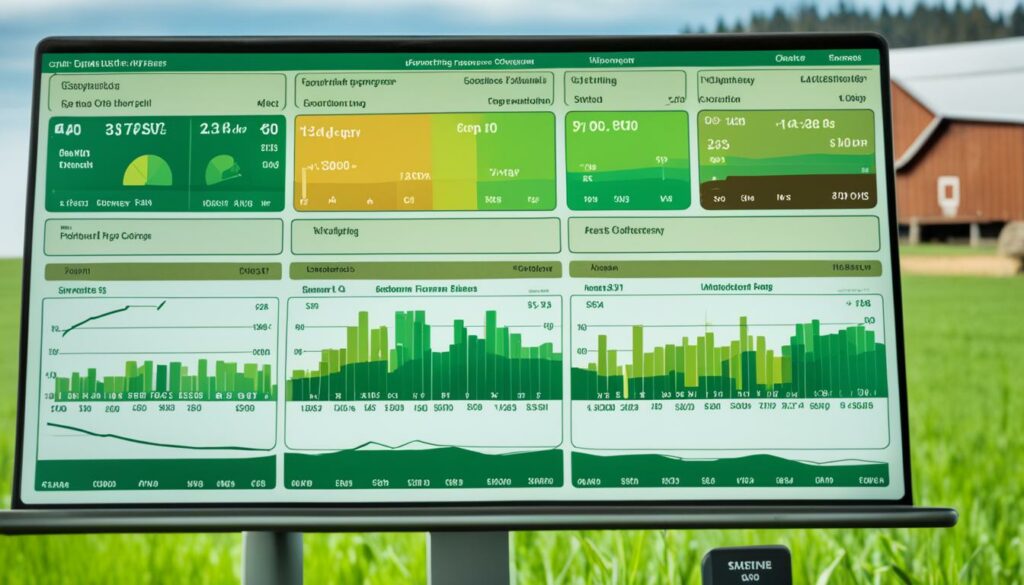
Farming software excels at handling farm data. It turns data into insights. This helps farmers make smarter choices for better operations and growth.
Farmers must keep costs under control to stay financially sound. Software watches the money, aiding in smart budgeting and planning. It’s a powerful tool for running a profitable operation.
Knowing what you have on hand is key. Farm software keeps detailed inventories. This avoid shortages, excesses, and keeps things running smoothly.
| Key Feature | Benefit |
|---|---|
| Data Analysis & Management | Supports informed decision-making through actionable insights. |
| Cost Management | Enhances financial stability by tracking and optimising expenses. |
| Inventory Management | Maintains accurate records, ensuring effective resource allocation. |
Exploring smart farms shows how they boost livestock productivity and use resources better. They use high-tech systems and sensors to gather important info. This info helps make smarter decisions in farming, leading to better production and greener farming practices.
Smart farming means using tech to make the best of resources and increase productivity. High-tech tools are used for better animal health, food, watching over them, and selling products. This mix of tech saves money, helps the environment, and improves the lives of farmers. It plays a big part in making livestock farming more efficient and higher quality.
Nowadays, farming has to be sustainable. Smart farms work towards this by using systems and tools that help the land and animals. They use less energy, cut down on waste, and keep the land healthy. Studies have shown that this approach is crucial for successful farming in the future. Smart farming is all about finding a balance with nature while working more efficiently.
| Feature | Benefit |
|---|---|
| Advanced Monitoring Systems | Enhances animal health management |
| Data-Driven Decision Making | Improves resource efficiency and productivity |
| Sustainable Practices | Minimises environmental impact |
In the livestock sector’s drive for sustainability, managing waste is key. When done right, waste becomes a resource, not just a byproduct.
Farmers can lessen their farms’ impact on the planet by using smart waste management. This includes composting, turning animal waste into fertilisers, and using tech to handle manure. In Colombia, a cattle ranch has cut down CO2 emissions by 1.05 million tons. They also saved almost 32,000 hectares of degraded land.
There are many ways to make livestock farming greener. Rotational grazing and improved manure handling can lower methane. In Uruguay, these efforts have increased carbon sequestration and boosted energy efficiency, especially in dairy farms.
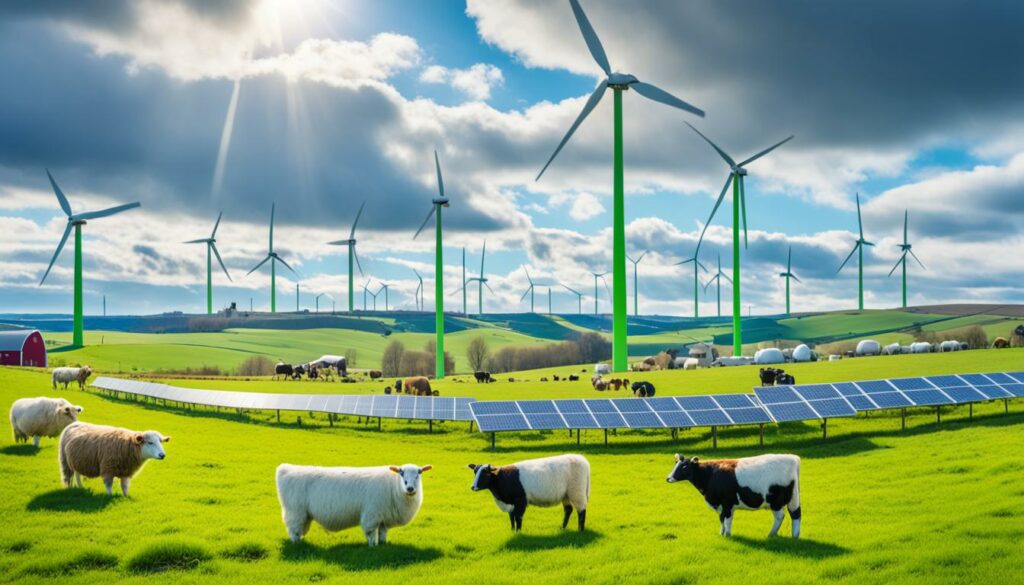
Selective breeding and better nutrition also play big roles in making farming greener. Improving what the animals eat can mean needing less livestock for the same results. Using new tech for animal care has also made farm management more sustainable.
Buying good feed really boosts how well farm animals grow and work. Each group of animals needs their own special mix to be their healthiest, grow well, and have babies easily. The right food helps make farming more money and keeps it going strong.
Animals get sick if they don’t get the right nutrients, and that makes them work less well. Adding special vitamins and minerals to their food can make a big difference. This makes animals stronger and they do better at their job, like making more milk or growing more meat.
Eating well is also key to having babies. For cows, not enough calcium, zinc, or selenium can make it hard to get pregnant. Strong, happy animals give more milk, meat, and eggs. A healthy diet doesn’t just mean more food; it means better food from the animals.
People are asking for farm goods that come from happy, healthy animals. To meet this wish, animals must be fed very well. This makes the quality and the amount of what they give us very good and follows what people want.
The use of new tech in raising animals is growing fast. By studying the genes of animals, farmers can make even better food for them. This smart farming helps in making more money from the farm and takes better care of the animals. It’s a big deal that many want to invest in.
With more and more people living in cities, the need for farm goods keeps going up. Finding new food for animals and making what they eat better is very important. It keeps the farm costs low but keeps the animals making a lot of good products.
Rotational grazing is great for managing pastures and making animals eat better. By moving animals between fields, we stop them from eating too much in one place. This keeps the grass healthy and allows it to grow back strong.
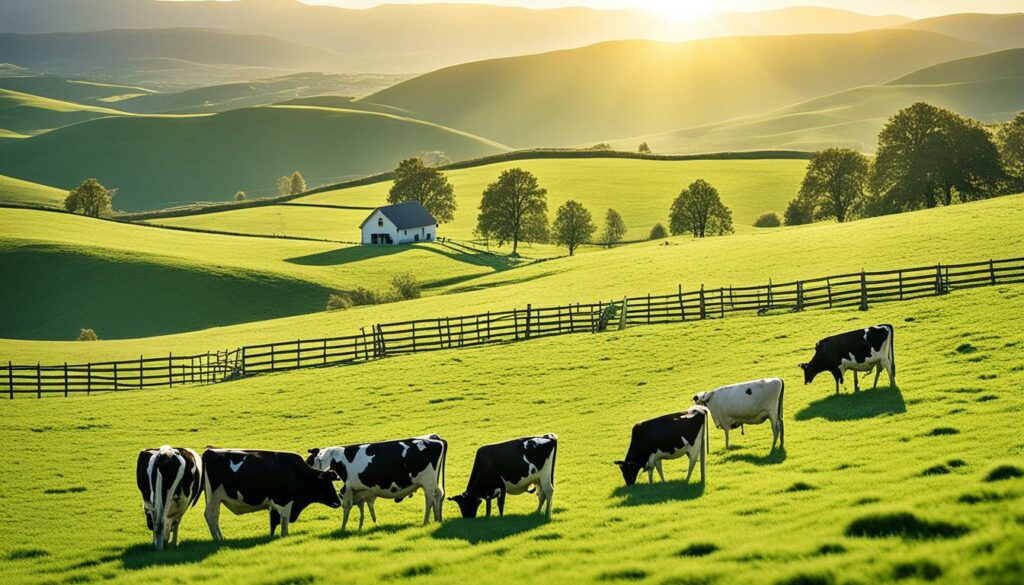
This method boosts the amount and quality of grass animals eat. It also means we can have more animals on the same land. This cuts down on how much food we have to buy for them in winter or dry times.
Rotational grazing can make the land and soil more fertile. It means we don’t have to add as much chemicals to the soil to help things grow. This is good for the environment and saves money.
This approach helps pastures survive droughts and stay productive longer without rain. Animals walking around less stop the ground from getting too hard, which is better for the grass. As a result, the food animals eat is healthier too.
It also makes the plants animals don’t like less common, which makes the pasture better for everyone. We can give the best grass to the animals that need it most, helping them stay healthy. Fields are set up to be just right for the time of year, making everything more efficient.
Rotational grazing does even more good. It’s like getting the grass ready to grow new grass by using animals to clear out some old plants. It protects the grass when there’s not enough rain, saving food costs for the animals.
It’s good for the animals too. They are less stressed and can fight off diseases better. This method also helps new plants grow by letting some go to seed, making the land more diverse and the animals’ diet better.
Finally, by making animals eat from all over the field, it keeps the grass they like best healthy. Copying how wild animals used to live helps the land stay good for growing new food. This way, we take care of the soil, which helps everyone.
| Benefit | Impact |
|---|---|
| Increased Forage Production | 30-70% increase annually |
| Stocking Efficiency | 30-70% more stock on same acreage |
| Reduction in Purchased Hay | Significant decrease during winter/drought |
| Soil Fertility | Enhanced through increased organic matter |
| Drought Resistance | Greater resilience and extended growth |
| Soil Compaction | Minimized through controlled grazing |
| Forage Quality | Enhanced through controlled grazing of less desirable plants |
| Natural Reseeding | Supports biodiversity and pasture regeneration |
Livestock management apps are key to making farms work better. They bring many benefits that make processes smoother and help the farm be more productive. With these apps, farmers can modernize their methods and reach new levels of success.
Modern apps for livestock help organise farm work better. They do this by automating tasks, checking animal health, and setting up feed plans well. By using this technology, farms work more efficiently, saving time and energy on important but repetitive jobs. This also means making smarter choices and using resources more effectively because of all the data and insights these apps provide.
Managing workforce well is a big benefit of these apps too. They help plan work, keep track of who’s there, and assign jobs to the team. This makes sure everyone works their best, reducing wasted effort and controlling labour costs. These apps also help keep farmworkers learning and improving their skills in farming, ensuring they know the latest and best methods.
Here are some useful features that these apps often include:
| Feature | Benefit |
|---|---|
| Health Monitoring | Early detection of illnesses to reduce livestock mortality rates. |
| Feeding Plans | Optimised nutrition schedules ensuring better feed utilisation. |
| Breeding Records | Data-backed decisions for genetic selection and breeding optimisation. |
| Task Scheduling | Improved labour productivity with streamlined task allocation. |
| Integrated Financial Management | Enhanced tracking of costs and revenue streams, improving financial efficiency. |
To sum up, using livestock management apps is a big step forward for farms. They make daily tasks run smoother and help manage workers better. This tech boosts productivity and supports the farm’s success and long-term growth.
Livestock tracking devices are changing the face of modern farming. They offer real-time tracking and help farmers better manage their animals. With more farms using automation, these tracking tools are becoming crucial.
Livestock tracking devices let farmers monitor their animals instantly. They spot health or behaviour problems quickly. Thanks to AI and powerful computers, these gadgets now have smart sensors and use advanced vision.
Companies like Cainthus have cameras that can recognise animals. This allows them to watch over actions like eating and drinking, all day. This detailed observation helps with animal health and running the farm better.
These devices also improve how decisions are made on the farm. They give insights that help manage the farm better. This includes things like animal health and making more animals without adding stress. AI helps cut costs, boost work, and keeps the animals happier.
The collected data makes it easier to make changes quickly. This ensures animals live in a way that’s natural and low-stress. It’s something experts like Tyler Bramble at Cainthus believe in.
Using more data shows the farming industry is moving towards tech. This is to meet the needs of the future’s big population. With more automation and tracking, farming can be more effective and eco-friendly.
Adding more livestock products can boost your income and help keep your money stable even when the market’s choppy. With beef sales climbing, this is an excellent time for farmers to broaden what they offer.
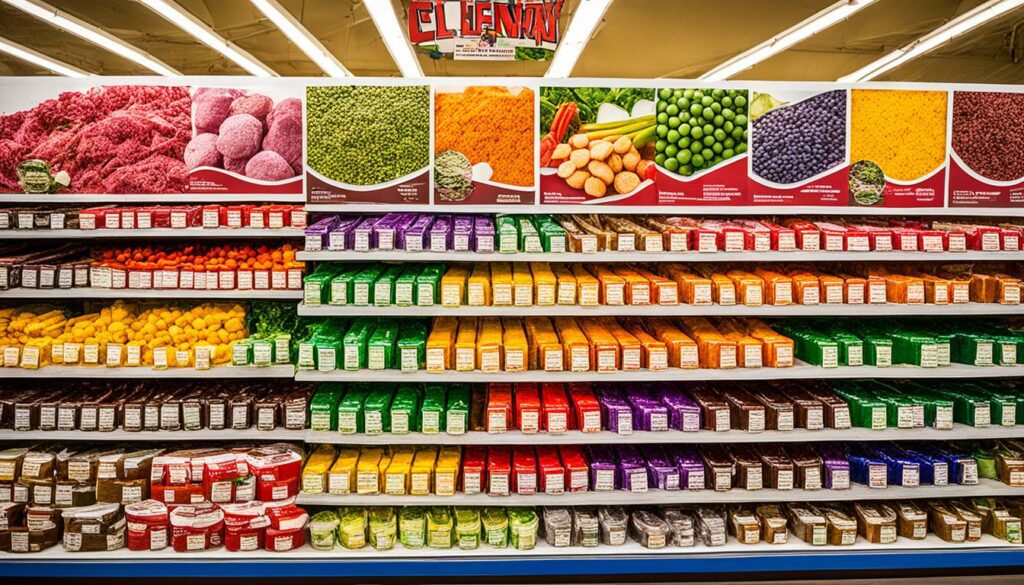
But, just depending on beef could be risky due to the increasing costs of things like food and vet care. By including different products, such as organic beef or using new technology like HerdView, you can make more money and be safer financially.
Take things like jerky or canned beef, for example. They reach more people, fight against climate change effects, and keep cows healthy. Looking into special markets and adding products can make you more financially secure and meet what the market wants.
Also, earning from agritourism or letting people use your land for fun can add to your income. This means you’ll have more money coming in regularly and make your farm stronger economically. Plus, things like goats or sheep can use your land better, which is good for managing your space.
By knowing what people want and planning well, you can smoothly add new things to sell. This not only means your business can last longer but also do better financially. Thus, it’s really important to mix up what you sell. This way, your income won’t just come from one place and can stand up to the tough parts of farming.
Investing in farm infrastructure is key for boosting livestock farming. It helps improve overall agricultural facilities too. This upgrading involves essential parts that make animals and farm work better.
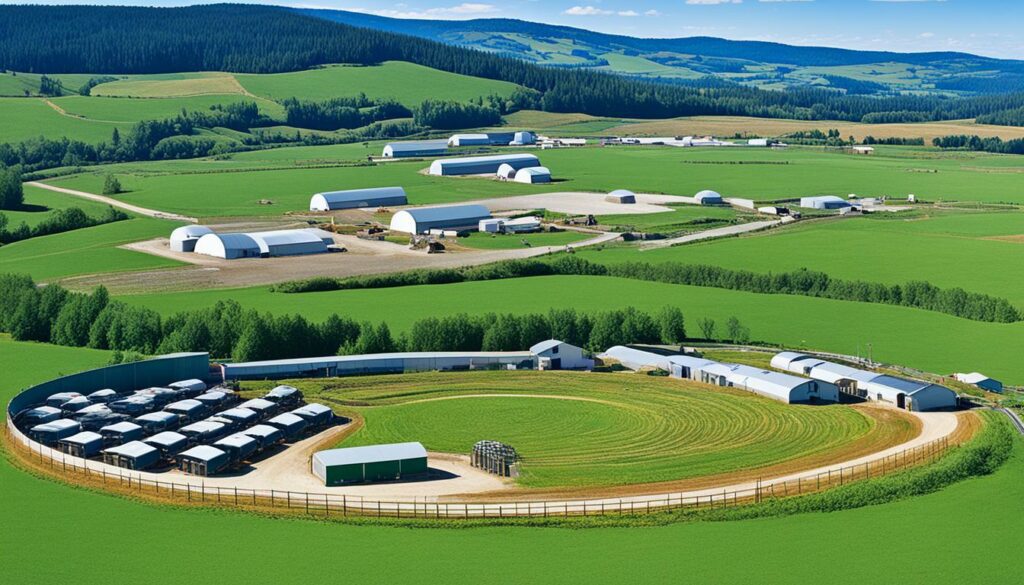
New technology in livestock farming, like IoT and sensors, can make farm work smarter. For instance, about 12% of dairy farms now use robots. Experts think this number will grow to 20% in five years. The investment in this area in the United States is over $30 billion each year.
Efforts to improve modern agricultural facilities focus on better housing and hygiene for animals. The U.S. Department of Agriculture has put $1.5 billion into improving over 180,000 farms in the next five years. These steps help directly to increase farm productivity.
Using technology and data for better farm work is becoming more common. It brings improvements in productivity and care for animals. But, there are still some challenges, like the cost of new technologies. The Inflation Reduction Act shows the government wants to help with this, providing a big investment in these areas.
The livestock industry is changing, putting cows and their wellbeing first. The aim is to make farm data easier to use and help farmers make better decisions. Strategic investment in farm infrastructure will keep this progress going in livestock farming and agricultural facilities.
| Aspect | Investment | Projected Growth |
|---|---|---|
| Robotic Use in Dairy Farms | 12% | 20% in 5 years |
| Livestock Management Market | $30 billion | Yearly Value |
| USDA RCPP Investment | $1.5 billion | Fiscal Year 2024 |
| Inflation Reduction Act Allocation for RCPP | $4.95 billion | Over 5 years |
Record-keeping is crucial for managing livestock effectively. It boosts the farm’s general efficiency and output. Through detailed records, farmers can monitor each animal’s progress. This makes decision-making easier in farming and supports the long-term growth of the farm.
Keeping comprehensive records significantly helps track how well livestock is doing. These records provide insights into things like how fast they grow, their reproductive past, and health. About 65% of large commercial farms use record-keeping software. This software reduces the time needed to handle data by 40% compared to doing it by hand. It helps farmers make smarter choices.
Good record-keeping leads to better decision-making. A study found that farms using the right tools were 20% more accurate in their funding and resource management. In addition, farms that use digital software were 15% more efficient. They could track data better and make fewer mistakes. This is key for dealing with unexpected situations. About 75% of farmers mentioned their business was better prepared thanks to their up-to-date records.
| Helped Factors | Percent Improved |
|---|---|
| Operational Efficiency | 15% |
| Decision-Making Accuracy | 20% |
| Business Continuity | 75% |
| Data Management Time Reduction | 40% |
Controlled environments in agriculture can change how we farm animals. They offer precise conditions for better health and more products. This deals with the changing weather well. It’s also linked to new technologies in farming that use data and analytics.
Precision farming uses data to make better choices, boosting how much we get from our farms. More robots are used on dairy farms now. The plan is they will help even more, growing from 12% to 20% more use in five years. This change is good for the business and the cows across the United States.
There are systems that watch over cows all day, like those from Cainthus. They give instant updates on the cows’ health and how much they do. These ideas have gotten much better over the last decade, helping animals and farms be more productive.
The future of farming inside controlled areas is set to focus more on the cows themselves. It’s about letting cows be more themselves while still giving a lot. Using animal science carefully in breeding can boost how much we get from our herds.
Yet, farming like this faces its own problems, such as how costs change over time. This approach calls for smarter tools that bring all our data together. By using the latest, we can hope for eco-friendly and efficient farming in the future.
We’ve learned how to make livestock more productive. It involves many things like making their genes better, managing what they eat, keeping them healthy, and using new science to breed them. Doing this makes the animals happier and work better for us.
Using different kinds of animal parents can make stronger and healthier babies. Also, keeping a close eye on their health is important. They should always have the right food to eat.
Letting animals graze on different areas of land helps the plants stay healthy, too. And giving them the best food boosts how well they perform. It’s also vital that farmers keep learning and use smart ways to run their farms.
By using what we know in new ways, we can make farming better for everyone. This must go hand in hand with taking care of the Earth. That means being careful with waste and trying not to harm the environment. This way, we can meet food needs without hurting the planet, making our food systems stronger and more able to face the future.
Livestock productivity tools include many modern technologies and methods. They help improve breeding programs, manage animal health, and make farm work smoother. These tools boost both the efficiency and productivity of farms.
Livestock management apps make daily tasks easier and help manage workers. They assist with setting schedules, keeping track of attendance, and using resources well. This leads to farms running more efficiently and effectively.
Detailed records are key in the breeding process. They provide important information on past breeding, help make future mating decisions, and trace ancestry. This is crucial for breeding programmes to improve and for livestock to grow stronger.
Getting the diet right for livestock keeps them healthy and increases their output. Using supplements can make low-quality feed more useful. This supports healthier animals and better productivity.
Checking on animal health often catches and fixes problems early, avoiding bigger issues. Working with vets on health checks and illness management boosts the whole farm’s health and how well it runs.
Precision livestock farming uses data to improve farm processes and make better use of resources. This reduces waste and increases productivity. It makes farms more efficient and effective.
Livestock software makes managing farms easier by analyzing data and tracking costs accurately. It also helps with inventory. It supports farmers in making smart choices and staying financially sound.
Smart farms use advanced technology to make better decisions and use resources more wisely. This promotes sustainable farming and significantly increases farm output.
Sustainable farming means managing waste, using green methods, and lowering environmental impact. This helps agriculture be more responsible.
Good feed is crucial for animals’ growth, health, and reproduction. It vastly improves how well livestock perform and how productive they are.
Rotating where animals graze helps manage pastures better and keeps them healthy. It improves grazing land and boosts farm efficiency.
Tracking devices help monitor animals’ locations and health in real time. They give quick, useful information to farmers, enhancing care and management.
Offering a variety of livestock items brings in more money and reduces financial risks. It makes farming more profitable and adaptable to change.
Good farm buildings and facilities are essential for breeding and keeping animals well. They need the right housing, space, and hygiene to thrive and be productive.
Keeping good records helps track progress in growth, breeding, and health. This is vital for making smart, informed choices in running the farm.
Controlled environments ensure animals grow and stay healthy, no matter the weather. This leads to farming more efficiently and sustainably.